
I recognized the tone of voice immediately and knew I was in trouble. It's the voice reserved for use before the kids are put into "time out." I have a fabulous wife who is beyond accommodating. For some reason, the big golf trips don't bother her, as she figures going to Ireland or Pebble Beach to play golf is a deserved vacation. It's these little trips that set her off for some reason. "Haven't you gone to Ohio three times already to play golf?" I find it best not to respond in these situations, and yes, I have indeed gone to Ohio three times before for golf. Attempting to explain how Ohio is one of the best golfing states in the country would have fallen on deaf ears.
I was on my way to Ohio again to play Camargo Club (ranked #63 in the world), which was built in the early 1920s during the golden era of golf course architecture. Seth Raynor, who also designed Yeamans Hall, Fishers Island and Shoreacres, designed and routed the course; however, he died prior to the course being completed. The course was completed by one of his associates, "Steamshovel" Banks, whom I have previously mentioned in my Whippoorwill post. They did a spectacular job. Camargo is one of the finest places I have ever played golf.
The beguiling course is situated on rolling terrain and has a masterful routing within a large swath of land that makes you feel like you are in a park. There are no houses surrounding the course and there is a large buffer around the edge that gives Camargo an open feel. The sweeping vistas create a sensational impression. Similar to Piping Rock on Long Island, the course was routed around a polo field, as you can see from the course map below.

As is typical of Raynor or Macdonald courses, the design has all the prototypical holes you would expect, such as a Biarritz, Eden, Short, Redan, Road, Alps and Punchbowl. I liked the feel of Camargo right from the get go. It's not hard to see why looking at the approach to the first green seen below. You can see how great the hilly terrain is and also note how the course has an almost polished look to it, given the beauty of the meandering fairways and gently rising hills.
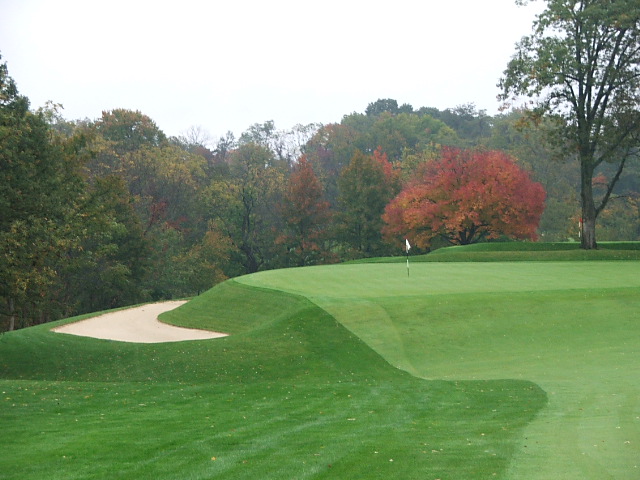
Camargo's first hole, "Leven", approach to the green
This hole, like many at Camargo, plays longer than the 390 yards on the card because you hit to an elevated table top green.

Par five second, with its rectangular green
The picture above is from the second green. This 529 yard par five is a big sweeping dogleg to the right that features an uphill tee shot followed by a shot down into a valley and then another shot back up again to the green. As at Yeamans Halls, the geometric look is characteristic of many greens at Camargo.
The third hole is a short 320 yard par four ("Leven") that plays over a ravine, up a hill, to a green that is set at an angle to the fairway and is well bunkered. You can again see one of the essential elements of Camargo, which is its aesthetic beauty. It just has a look to it that is very pleasing to the eye. Similar to the effect achieved with an Italian Renaissance garden or a formal French garden, the use of symmetry and the manner in which the landscape is tied together is brilliant. There is something that's hard to describe about how all the angles come together and make it look artistic. I know it's just a golf course and I'm getting all lathered up here, but even on a cloudy day this place shines!
The above picture is the elevated green on the third hole as seen from behind, which shows the extent of the bunkering, which I found very similar to the bunkering on the 8th and 14th holes at the C.B. MacDonald designed Chicago Golf Club.
The alluring par three fifth hole is an "Eden" prototype. It is set in an idyllic, quiet little alcove. It's one of the best holes I've played and a real beast at 179 yards. It is in a secluded spot, carved out of the woods, and what makes it so terrifying is the angle the green is set at from the tee. When standing on the tee box there are dense trees surrounding you for almost 360 degress. The long, narrow green is set at an obtuse angle to the tee and has a huge bunker along the left hand side and a fifteen foot fall off.
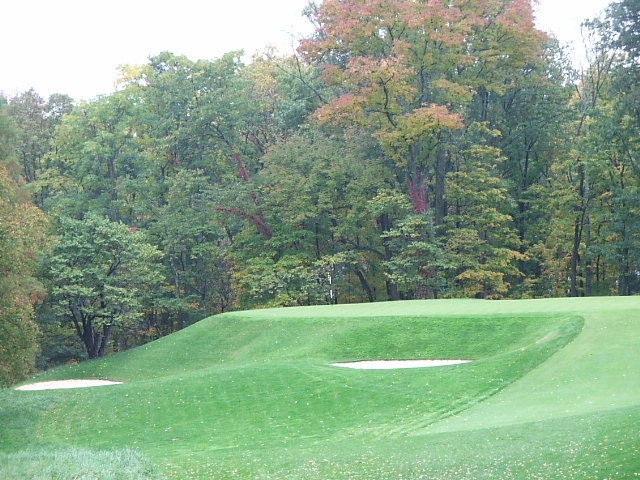
The "Eden", par three fifth hole
As I usually do, I did my research before playing Camargo and had read that it had the best collection of par threes outside of Cypress Point, which set my expectations high. Seeing the fifth hole didn't dampen my expectations.
Given the wind conditions on the day we played, I thought holes 7-9, the "Alps", "Biarritz" and "Long" holes, were the toughest stretch on the course. The Biarritz hole plays 227 yards and is a bear. Check the box on another great par three. Like the truly great courses (Pine Valley, Cypress, Somerset Hills, National, Sunningdale), Camargo has a great routing where nothing feels forced and it follows the terrain naturally.
The tenth hole, "Shinnecock," is a sweeping dogleg to the left and as seen above, has a green that is typical of Camargo: large and elevated with sharp angular fall offs and very deep bunkers.
The breathtaking prototype "Short" hole is the eleventh. It plays 140 yards from the back tees to a green set below you. Although the hole is not long, you have to hit the green or you are in trouble. The green, like all greens at Camargo, is large, which makes it a challenge if you are not close to the pin. How many par threes can you recall that look prettier than this? Not even including the par three Redan hole, I actually do think this place might have the best par threes outside of Cypress. Maybe Woodhall Spa and Pine Valley would be in the running also, but Camargo would be on any short list.
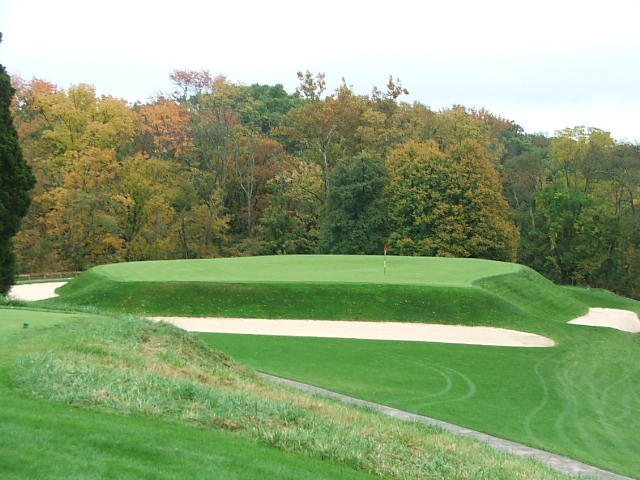
The par three "Short" eleventh green
The club keeps a low profile, and this is a good thing. One of the things that makes golf such a great pursuit is that you get to play in historic venues such as Camargo. It is an unspoiled masterpiece. Thanks to an enlightened membership, the course has changed little since it was built, and it is like being transported back in time. It's as if you are able to step back in time and play baseball at the Polo Grounds or Ebbets Field in 1922. The club hired Tom Doak to do restoration work several years ago. Apparently, he restored many of the greens to their original larger sizes as they had been made smaller over the years. Aside from the Old Course at St. Andrews, I can't remember a course that has bigger greens than Camargo. Combine Doak's work with a greenskeeper who is at the top of his game and you get a course that sparkles.

The seventeenth ("Road Hole") green
The seventeenth ("Road Hole") is one of only two par fives on the course. This closeup shot of the Pac-Man shaped green shows how masterfully Raynor and Banks could use "squared off" shapes and sharp angles, yet still somehow have the course retain such a natural look.
Camargo is short by today's standards at 6,659 yards from the back tees, and there is no water on the course. The primary defense the course has is the hilly terrain and greens with a multitude of protections: deep bunkering, the greens' large size and their big undulations.

The eighteenth fairway as seen from the tee
Having now completed all five world-ranked courses in Ohio, I would rank them in the following order: 1. Camargo 2. The Golf Club 3. Muirfield Village 4. Inverness 5. Scioto.
The Club
Like at Yeamans Hall, the clubhouse is my favorite type: understated. It reminded me of the Valley Club of Montecito inside with its small locker room with original wooden lockers and a very cozy, miniscule bar area with dark wood. These 1920s vintage clubhouses are worth their weight in gold. We played on a chilly fall day and it proved an ideal place for an après round drink.
The club logo shown on the scorecard has a shoe and gun above the crest, as well as a polo mallet and a golf club. The explanation is that Camargo has a skeet shooting range (which is about to close), tennis, platform tennis and two polo fields (not in use any more). The logo incorporates all the sports pursued at the club.
So what exactly is a Camargo anyhow? There are several schools of thought. Among the members, some believe it comes from the French ballerina named Camargo, which is the subject of a painting hanging in the clubhouse. Others believe the club was named after a Mexican border town of the same name.

The French Ballerina Camargo
As the Mrs. has surmised, I may indeed be out of control, but I'm having a hell of a time. My mates and I have a handful of rules we like to following for pursuing this quest: Be a polite guest, tip the caddies generously, play fast, always offer to pay for everything and send a thank you note when done. The cardinal rule, though, is: NEVER EVER ADD UP THE COST of this pursuit. Nothing good can ever come from it.
And it's a damn good thing my wife found the itinerary only, instead of the bill. I'm living the dream out here!
Post Script
When in Cincinnati, visit Graeters, a local institution that has been serving exceptional ice cream since 1870; it is worth a detour.
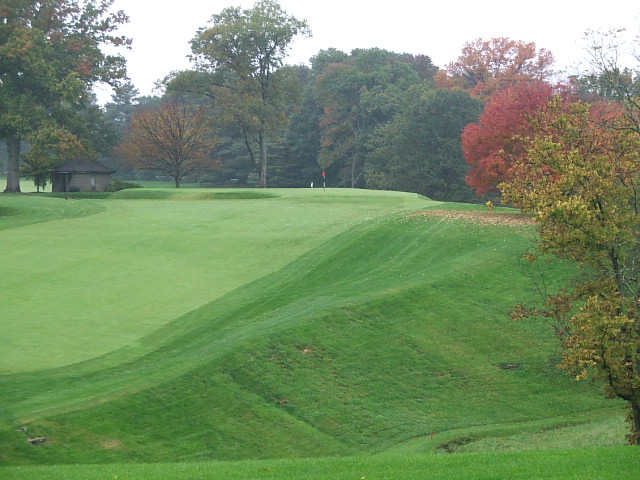
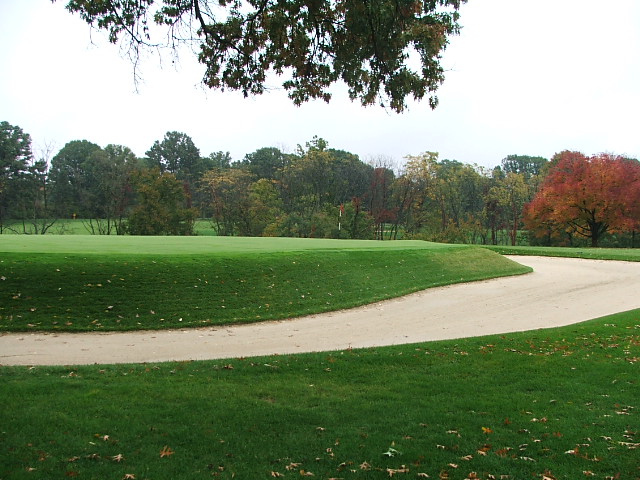

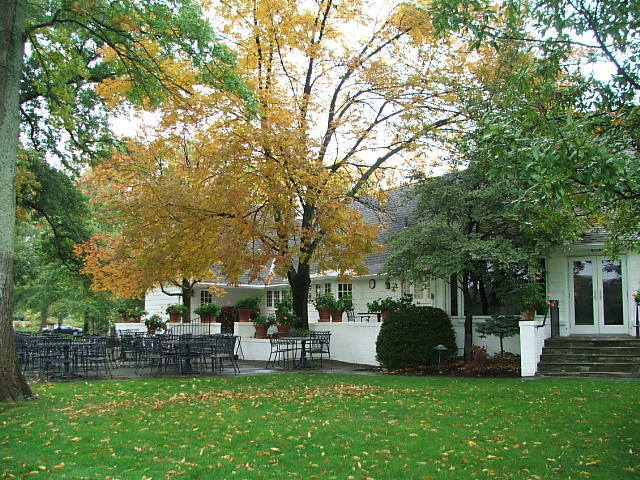
No comments:
Post a Comment